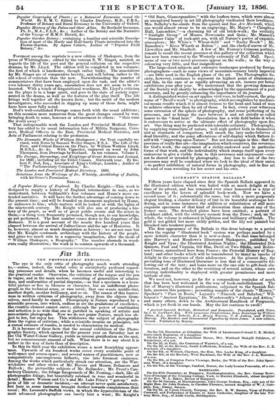lint 3,rto.
Tan PHOTOGRAPHIC EXHIBITION.
"The eye is the only critic of photography much worth attending to,—unless, indeed, the verbal critic is scientifically profound regard- ing processes and details, when he becomes useful and interesting to the practical reader. Otnerwise, the criticism of the tongue and the pen is vague, and in the main useless; consisting of generalities of admire- Zion, and uniformities of partial dispraise,—as that a specimen is a beau- tiful picture or fine in likeness or character, but an indifferent photo- graph. in the technical sense, or -vice versa ; ihat one wants middle-tint, another depth, another brilliancy, and so on. The reason of this barren- ness in written criticism of photography, away from the objects them- selves, need hardly be stated. Photography is Nature reproduced by a scientific process, into which, endless as are the gradations of excellence, the creativa element cannot enter; although the power of combination and selection is so wide that one is justified in speaking of artistic and non-artistic photographs. Now we do not praise Nature, much less ob- ject to her, but enjoy her. This withdraws the subject of photography from the refion of criticism; while a scientific treatise on principles, not ▪ casual estimate of results, is needed to characterize its method. It is because of these facts that the annual exhibition of the Photo- 'e‘ Society, which opened for the present year on Saturday last at e Old Water-Colour Gallery, yields us intense gratification on the spot, but no commensurate amount of talk. What there is to say about it is rather iii the way of facts than of description. In this its third year the exhibition wears a most flourishing appear- Imes. Upwards of six hundred works cover every available point of wall-space and screen-space ; and several names of practitioners, new or comparatively unconspicnous hitherto, rise into foremost eminence. Among the works which particularly struck our attention, are the War- wickshire and other views of Mr. Havers and Messrs. Dolamore and
Can-
terbury Cloisters ; the foliage ands of Mr. Ponting,—dark, hie all
Bullock ; the picturelike subjects of Mr. Rejlander ; Mr. Prout's photographic foliage, but beautifully y subdued in tone and wonderful in
detail ; Messrs. Watson and Co.'s and Mr. Lake Price's " got-up " sub- jects of life or dramatic incident,—an attempt never quite satisfactory, but here in some instances brought further towards completeness than usual ; Mr. Leverett's Suffolk views, in which the hypercriticism of the most advanced photographer can barely hint a want ; Mr. Knight's
"Old Barn, Glamorganahire," with the leafless trees, which were almost an unexplored beauty in art till photography vindicated their loveliness; Mrs. Sotheby's fae-simile from the quaint and fine Ara Heriendi, which one would almost swear to be an engraving; Mr. Major's " Claughton Hall, Lancashire,"—.a charming bit of old brick-work; the veritably "Sunlight Group" of Messrs. Newcombe and Quin; Mr. Mansell's "Summer Calm' of rock-girt sea, with all Nature's poetry of exquisite atmosphere ; Mr. White's Wheat-field" and "Rushy Brook" ; Mt. Ramsden's "River Wharfe at Bolton" ; and the chefs-d'teuvre of Mr. Llewellyn and Mr. Shadbolt. A few of Mr. Fenton's Crimean portraits remain to recall the recent presence at this gallery of the collection which has now been removed to the Westerly extremity of Pall Mall. Speci- mens of one or two novel processes appear on the walls ; in the 'way of colouring very little, and that insignificant.
The large-sized subjects and extensive landscapes produced by foreign photographers—such as some views of mountain-scenery lately imported —axe little used in the English phase of the art. The Photographic So- ciety, however, continues to represent its highest point of attainment; and this, in the case of so rapidly advancing an art, insures yet better exhibitions year after year. We understand that the growing demands of the Society will shortly be acknowledged by the appointment of a paid secretary, and by greatly enhancing the importance of its journal.
A distinguished writer on art applies viva voce, in half-earnest, the grim name of "Devil's work" to photography, which accomplishes by mechani. cal means results which it is almost treason to the head and hand of man to achieve otherwise than by aid of these. In fact, every year witnesses some extension of the sphere of photography, and some perfecting of its processes, and so brings the race between it and art strictly so called nearer to the "dead heat." Speculation has a wide field before it when it endeavours to arrive at the ultimate effect of photography upon fine art. One thing may predicted with tolerable certainty. Photography, by supplying transcnptsof nature well nigh perfect both in themselves and as standards of comparison, ;sill smash the lazy make-believes of dead literality, and the puny affectations of self-display which flatters it- self with improving upon Nature." But not less certitin is this : that the provinoe of really fine art—the imagination which conceives, the reverence for God's work, the enjoyment of a richly-endowed soul in particular forms of that work, and the individuality which stamps itself upon every endeavour to give a visible form to this reverence and enjoyment—can- not be shared or invaded by photography. Any loss to one of the two processes may well be condoned when we look to the ideal of their union —to perfect exhibition of natural forms in photography, and in fine art the soul of man wrestling for her secret and his own.


























 Previous page
Previous page